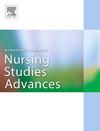埃塞俄比亚奥罗米亚地区公立医院护士预防导尿管相关尿路感染的知识和实践及其相关因素:横断面调查
IF 3.1
Q1 NURSING
International Journal of Nursing Studies Advances
Pub Date : 2024-12-10
DOI:10.1016/j.ijnsa.2024.100281
引用次数: 0
摘要
背景:导尿管相关性尿路感染是最常见的医院感染,与严重的全身性感染相关,这意味着住院时间延长,住院费用增加,发病率和死亡率增加。在埃塞俄比亚奥罗米亚,缺乏与护士预防尿路感染相关的知识和实践相关的证据。了解护士对导尿管相关性尿路感染及其相关因素的知识和预防实践,对制定预防策略具有重要意义。目的:了解埃塞俄比亚奥罗米亚地区公立医院护士预防导尿管相关性尿路感染的知识、行为及其相关因素。方法:对埃塞俄比亚奥罗米亚州公立医院422名护士进行机构横断面调查。受访者是通过简单的随机抽样方法选择的。采用结构化的自我管理问卷来收集数据。通过数据分析,描述尿路导管相关性感染预防的知识和实践及其相关因素。结果:422名受访护士中,408名(96.7%)回复问卷。结果显示,63.5%的护士对预防导管相关性尿路感染有足够的知识,34.6%的护士对预防导管相关性尿路感染有良好的实践。在职培训(调整优势比:1.862,95%置信区间(1.11-3.14))、在重症监护室工作(调整优势比:3.148,95%置信区间(1.13-8.75))、感知到图书馆的可用性(调整优势比:2.97,95%置信区间(1.78-4.96))和指南的可及性(调整优势比:2.78,95%置信区间(1.49-5.16))是与护士知识相关的因素。工作年限(调整优势比:3.63,95%置信区间(1.55 ~ 8.47))、工作单位(手术室)(调整优势比:2.37,95%置信区间(1.08 ~ 5.19))、在职培训(调整优势比:1.905,95%置信区间(1.21 ~ 3.24))、上网(调整优势比:5.82,95%置信区间(2.45 ~ 11.30))、良好态度(调整优势比:1.89, 95%可信区间(1.07-3.15)与护士预防尿路感染的做法有统计学意义。结论:超过三分之一的受访者知识不足,而不到三分之二的受访者实践不足,这表明在预防导尿管相关性尿路感染方面存在知识与实践差距。在职培训、护士目前的工作单位和指南的存在与护士对预防导尿管相关性尿路感染的知识和实践显著相关。本文章由计算机程序翻译,如有差异,请以英文原文为准。
Knowledge and practice of catheter-related urinary tract infection prevention and its associated factors among nurses working at public hospitals, in the Oromia region of Ethiopia: Cross-sectional survey
Background
Catheter associated urinary tract infection is the most common nosocomial infection that is associated with serious systemic infections that imply prolonged hospital stay, financial costs for hospitalization, and increased morbidity, and mortality. There is a dearth of evidence related to nurse's knowledge and practice of catheter associated urinary tract infection prevention in Oromia, Ethiopia. Determining the nurse's knowledge and preventive practice of catheter associated urinary tract infections and their associated factors is important for developing strategies of its prevention.
Objective
To assess the knowledge and practice of catheter associated urinary tract infection prevention and its associated factors among nurses working at public hospitals in the Oromia region, Ethiopia.
Methods
Institution-based cross-sectional study was conducted among 422 nurses working at public hospitals in the Oromia, Ethiopia. The respondents were selected by a simple random sampling technique. A structured self-administered questionnaire was used to collect the data. Data analysis was done to describe the knowledge and practice of catheter associated urinary tract infection prevention and its associated factors.
Result
Of the 422 nurses surveyed, 408 (96.7 %) returned their questionnaire. The result shows that 63.5 % of nurses had adequate knowledge while 34.6 % of them had good practice of catheter associated urinary tract infection prevention. In-service training (adjusted odds ratio: 1.862, 95 % confidence interval (1.11–3.14)), working in an intensive care unit (adjusted odds ratio: 3.148, 95 % confidence interval (1.13–8.75)) perceived availability of library (adjusted odds ratio: 2.97, 95 % confidence interval (1.78–4.96)) and access to guideline (adjusted odds ratio: 2.78, 95 % confidence interval (1.49–5.16)) were factors found to be statistically significantly associated with the nurses’ knowledge. Years of experience (adjusted odds ratio: 3.63, 95 % confidence interval (1.55–8.47)), working unit (operating theatre room) (adjusted odds ratio: 2.37, 95 % confidence interval (1.08–5.19)), in-service training (adjusted odds ratio: 1.905, 95 % confidence interval (1.21–3.24)), internet access (adjusted odds ratio: 5.82, 95 % confidence interval (2.45–11.30)) and favourable attitude (adjusted odds ratio: 1.89, 95 % confidence interval (1.07–3.15) were statistically significantly associated with the nurses practice of catheter associated urinary tract infection prevention.
Conclusions
More than one-third of the respondents have inadequate knowledge while less than two-thirds of the respondents have inadequate practices which suggests the presence of knowledge to practice gap in catheter associated urinary tract infection prevention. In-service training, nurse's current working unit, and the presence of a guideline were significantly associated with both the knowledge and practice of nurses toward catheter associated urinary tract infection prevention.
求助全文
通过发布文献求助,成功后即可免费获取论文全文。
去求助
来源期刊

International Journal of Nursing Studies Advances
Nursing-General Nursing
CiteScore
5.80
自引率
0.00%
发文量
45
审稿时长
81 days
 求助内容:
求助内容: 应助结果提醒方式:
应助结果提醒方式:


